Comparing the words and worlds of Tolkien, Lewis and Rowling
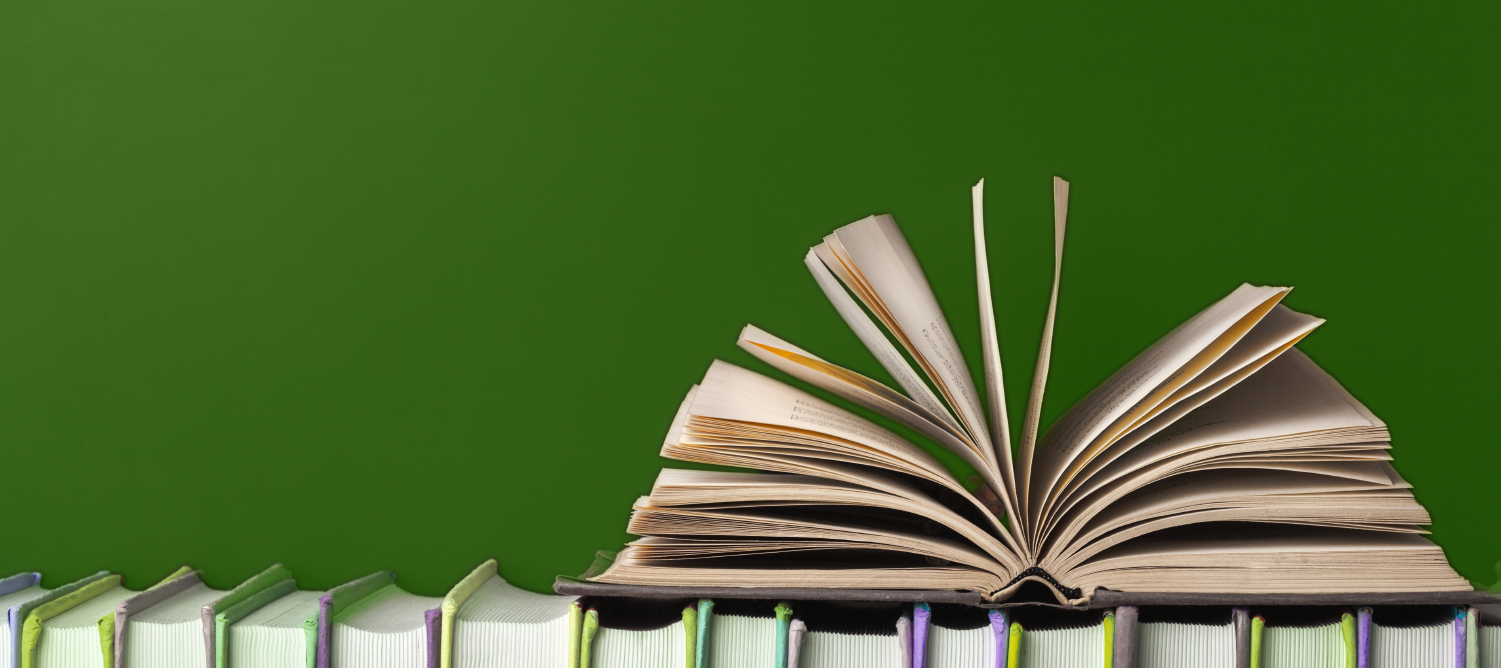
Relative Insight’s platform can compare any text files and almost every source of language data there is – so what text file is more comprehensive and rich and qualitative, than the language found in books?
In fact, Relative Insight’s founders first applied their comparative text analytics methodology to analysing the words in books, so in this piece we really go back to our roots!
THE DATA
We analysed the writing styles, topics and stylistic characteristics of three authors: J.R.R. Tolkien with “The Hobbit”, “The Lord of the Rings” and “Silmarillion”, C.S. Lewis with “The Chronicles of Narnia”, and J.K. Rowling with the “Harry Potter” series.
All these are fantasy books sharing some similarities. Tolkien and Lewis wrote about imaginary worlds; Lewis and Rowling’s main characters are children; Tolkien and Rowling’s heroes fight against a dark power. All stories involve some classic fantastic creatures including dragons, elves and dwarves.
There are of course obvious differences between the books: some words are highly important or even unique for a particular universe. For example, “ring”, “fellowship”, and ”ringwraiths” will only occur in Tolkein novels and doesn’t tell us anything that we couldn’t expect, and one does not use Relative Insight to search for obvious things. Let’s see if we can uncover something less trivial!
COMPARING TOPICS
Light and dark
Tolkien uses far more words relating to colour and light than the other authors. Sun, light and white are associated with positive heroes, darkness, shadow and dark, black colours with negative characters.
This stark difference between Tolkien and Lewis is rather expected as there is no prevailing dark power in Lewis’s stories. It is more surprising that Rowling doesn’t use the opposition of light and dark as much as Tolkien, although the Dark Lord plays a significant role in her books. Rowling does not associate physical parameters such as colour and light with being ‘good’ or ‘bad’.
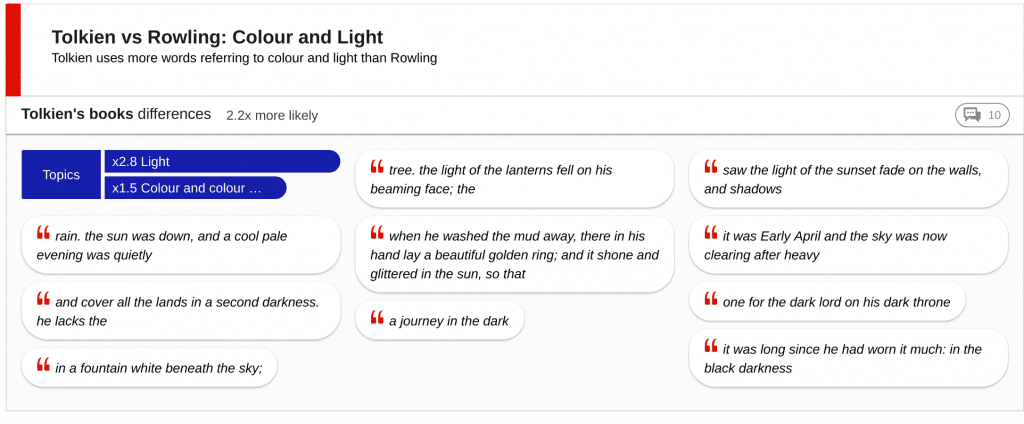

The idea of a journey
A quest is a compositional centre of Tolkien’s books: his heroes seek a particular goal, be it the return of Silmarils, dragon’s treasure, or destruction of the Ring. Lewis only uses the word quest for prince Caspian’s sailing, and interestingly, Rowling doesn’t refer to Harry Potter’s fight against Voldemort as a quest at all.
Tolkien uses more words related to danger than both Lewis and Rowling, and his heroes constantly face dangerous or perilous situations. Lewis and Rowling apparently allow their heroes to enjoy some more calmer moments.
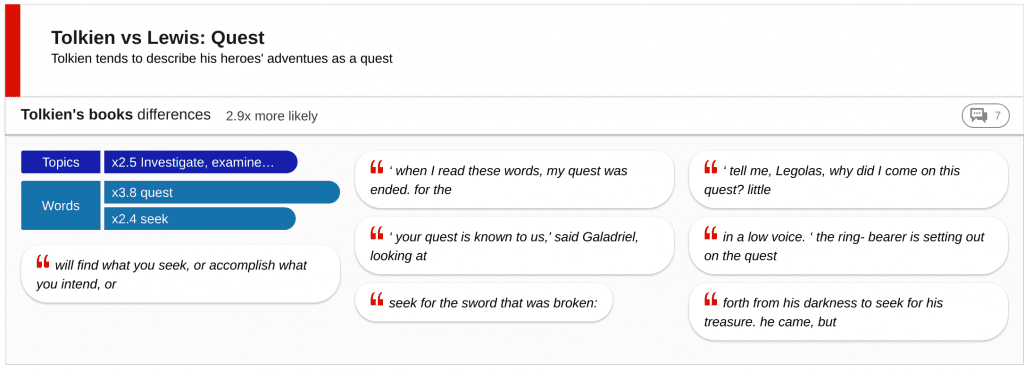

Weather and the world
Unexpectedly, certain physical elements of the world, such as weather and plants, occur more often in Tolkien’s books than in either of the other two. That’s not a surprise in case of Rowling, as Harry Potter’s adventures mostly take place inside buildings. But Lewis also mentions weather and plants less frequently than Tolkien, although his heroes do travel all around the world.
Tolkien seems to pay great attention to the weather and nature, which is often related to the situations faced by his heroes’, and is linked directly to their mood. Flowers, grass and green trees are symbols of peace and happiness, while gusts of wind and creeping mists come at the time of trouble.
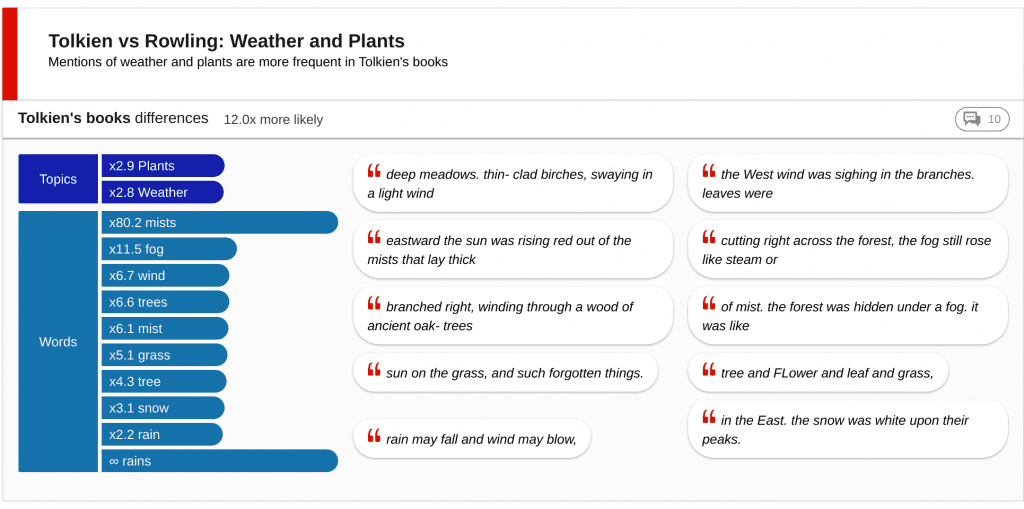

Lewis, in turn, assigns more importance to living creatures than to the weather. Animals talk, and often accompany human heroes in their adventures. In fact, one of the books is entitled “The Horse and His Boy”.
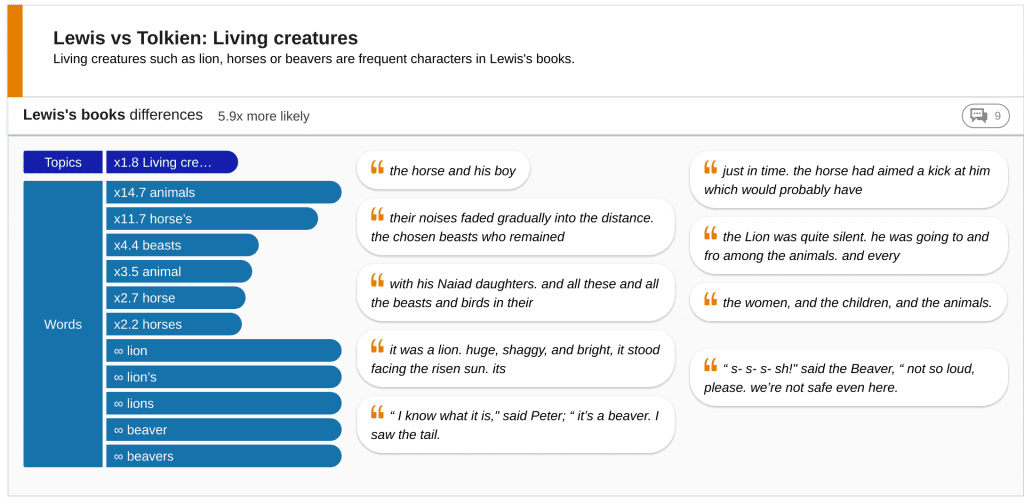

The ticking hands of time
The concept of time is present in all author’s books, but in different aspects. Tolkien’s books are oriented towards the past, mentioning old times and ancient history, epochs coming to an end. Lewis’s books, on the contrary, look towards the future, talking about the young world and young stars, events that begin, and those that continue forever. Rowling’s stories are rather future-oriented, but contain less time-related topics, being focused mostly on “here and now”.
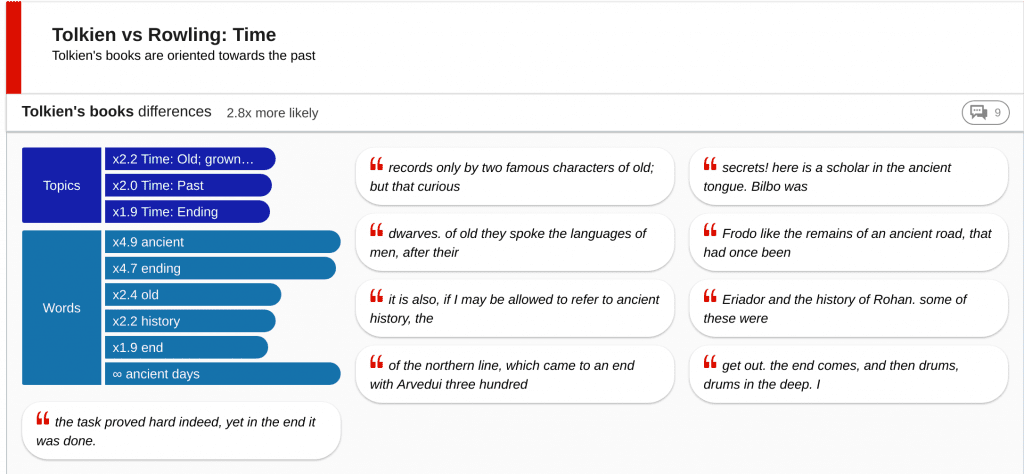

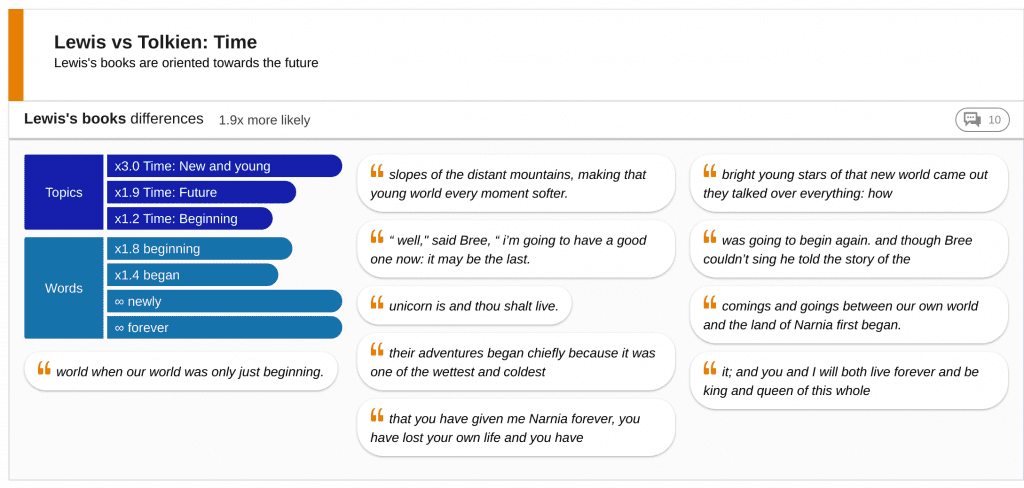

Rowling stands out compared to others as using much more expressions of emotions. This author seems to pay more attention to her heroes’ inner world as she follows them during a seven-year-long story, observing them grow up, develop their characters, build relationships, find their place in the world, and engage in a war with an all-powerful dark force.
COMPARING STYLE AND GRAMMAR
Topics differ across an author’s works and so are not much help in identifying the author of a text. What are the parameters of text that are likely to remain similar for all books of a given author? Grammar and text structure! Let’s see if we can find any differences on this side.
Degree and quantities
Tolkien uses more words denoting quantities (such as few, no) and maximizers (such as many), than Lewis and Rowling. But Lewis, in turn, uses more degree boosters, approximators and minimizers then either Tolkien and Rowling.
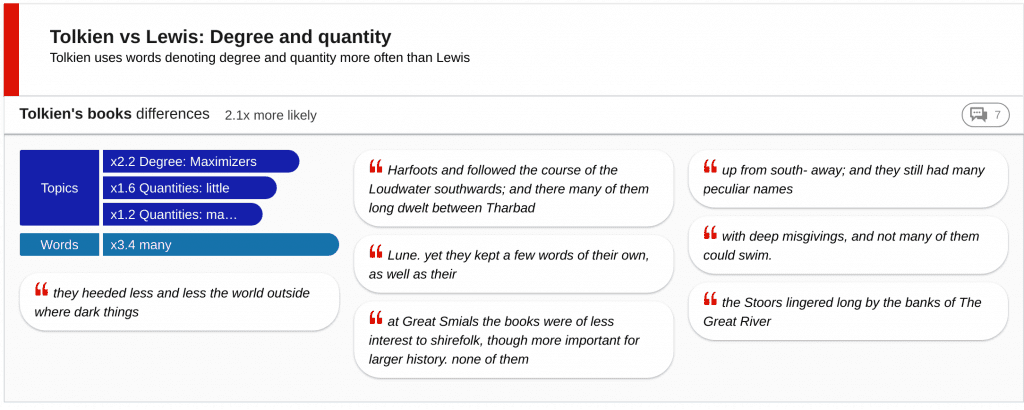

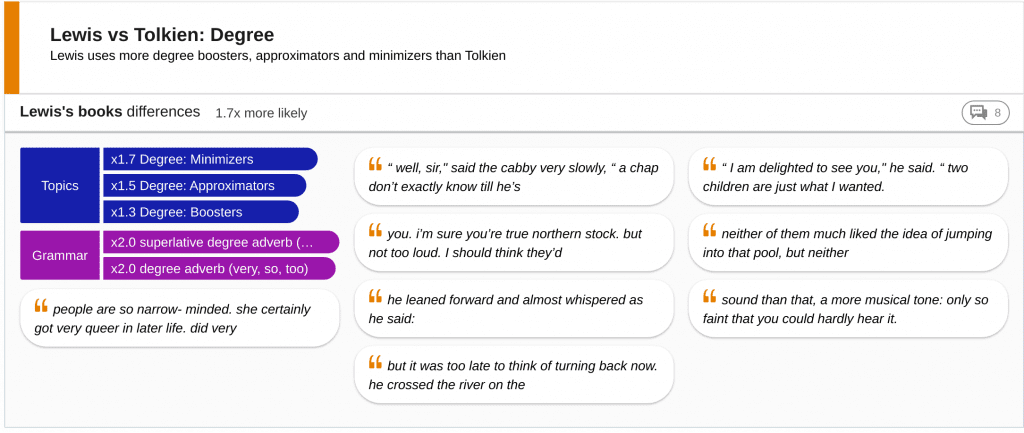

Such differences are harder to explain than topic-related ones. The contrast between many and few things (for example, those done, known, or forgotten) seem to mean a lot to Tolkien. For Lewis, on the other hand, it appears important to capture variations in values of attributes: very slowly, more musical.
Discourse
Rowling uses more discourse markers and interjections (oh, ah, particles yes and no) than Lewis, and Lewis more than Tolkien. Rowling and Lewis tend to use more colloquial language than Tolkien, their heroes express more emotions and hesitations.
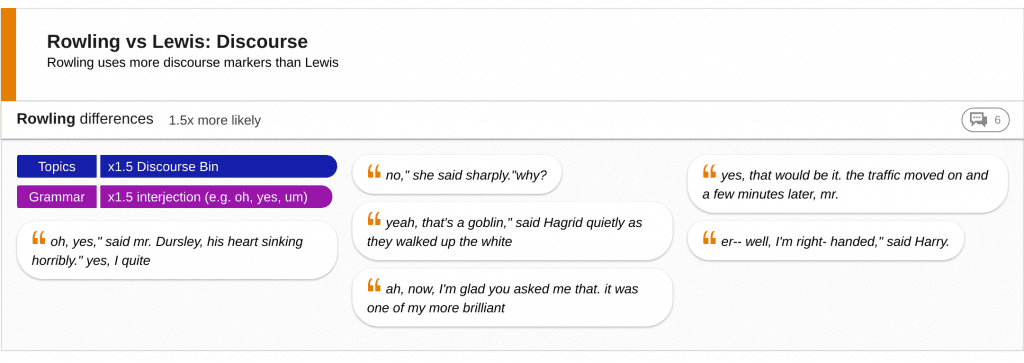

Generics
Lewis uses more generic words, such as thing or sort, than the other authors, and the fact that Lewis’s heroes explore a whole new world, with many unknown things of all sorts, might play a role in such word choice. We could continue to list the differences we discovered using our platform for a long time. Tolkien uses more articles “the” and prepositions “of” than Lewis and Rowling – he loves constructions like “the land of Mordor” or “the hobbits of the Shire”. He uses more modal verbs, negations, 1st person pronouns, but let’s stop there.
What we found during this analysis of millions of words was that most of the differences are not directly related to the books’ contents – but are more characteristic of an author’s general style than specific words and topics used.
Since James and Phil first founded Relative Insight, the platform has moved on from comparing words in books. However, the principle of looking at two or more data sources and spotting differences as a method of analysis remains exactly the same.
We can analyse any form of language data – from social listening data to surveys, reviews and qualitative research – the possibilities are endless!
